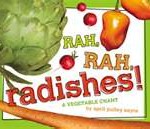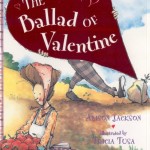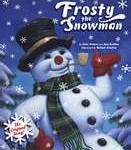Rah, Rah, Radishes!
 Three cheers for April Pulley Sayre and Rah, Rah, Radishes! A Vegetable Chant! How do you make healthy eating fun? With Sayre’s vibrant photos of vegetables taken at her local farmer’s market paired with her contagious rhymes:
Three cheers for April Pulley Sayre and Rah, Rah, Radishes! A Vegetable Chant! How do you make healthy eating fun? With Sayre’s vibrant photos of vegetables taken at her local farmer’s market paired with her contagious rhymes:
“Oh boy, bok choy!
Brussels sprout.
Broccoli. Cauliflower.
Shout it out!”
Start your lesson by asking students, “What do you think kohlrabi is? How about fennel? Rutabaga?” Read Rah, Rah, Radishes! and see if your kids can discover what those uncommon words mean. Encourage kids to chime in as you reread (“Go, green bean!”) Play “Cross the Line”: all the kids stand one one side of the classroom and imagine an invisible line down the middle of the room – or put down tape if your maintenance team won’t go nuts. Say “Cross the line if you’ve tried broccoli,” asparagus, the vegetables listed in the book. Have kids brainstorm vegetables that didn’t make the book. Is a tomato a vegetable? Find out in the back of Sayre’s book! If you have time and funds, bring in some vegetables for kids to try! Take photos of the vegetables and have kids use those Logic Smarts to sort the photos – by color, by part of plant (root, stem, leaf, or fruit), by which they liked and which they didn’t. With all the gorgeous colors of fresh produce, you can make a “color wheel” using vegetables – challenge kids to eat a rainbow! Rah, Rah, Radishes, hooray healthy eating, and super job, Ms. Sayre!
For more information, visit aprilsayre.com.
Read MoreThe Piggy in the Puddle
 “See the piggy,
“See the piggy,
see the puddle,
see the muddy little puddle.
See the piggy in the middle
of the muddy little puddle.”
This classic tongue-twisting pig tale, The Piggy in the Puddle, by Charlotte Pomerantz and James Marshall is almost 40 years old, and it is still pure fun to read aloud. The muddy little piggy in the middle of the puddle is told by her family that she must come out of the “squishy-squashy”, “mooshy-squooshy”, “oofy-poofy” mud. Her reply? “Nope!” So what’s a pig to do but join her? Soon the whole family, “big and little”, are “in the very merry middle.”
After you’ve read this book through once just for fun, see if your listeners can keep a simple beat for you as you read it aloud again – just make sure the beat isn’t too fast or you’ll end up tongue-tied! You can use this book with preschoolers through third graders to talk about sounds. Little ones can focus on beginning sounds of P and M, older ones can sort words with short i or short u sounds, or look for “double letters”. For a super-simple craft (because that’s how I roll), I die-cut pigs for kids to glue to construction paper, and then, using just one fingertip (so we wouldn’t end up muddy like the pigs) we dabbed brown paint on our paper to make mud puddles and muddy piggies. Good, clean(ish) fun!
For more information, visit charlottepomerantz.com.
Read MoreThe Ballad of Valentine
 “Oh my darling, oh my darling, oh my darling Valentine,
“Oh my darling, oh my darling, oh my darling Valentine,
I have written forty letters, but you’ve never read a line.”
Alison Jackson and Tricia Tusa have me singing this Valentine’s Day. In their book, The Ballad of Valentine, a narrator tries most every way he can to let his true love know how he feels about her: he trains a homing pigeon and attaches a note with twine, taps a note in Morse code “asking you to please be mine”, rents out a mail car on the westward railroad line, but nothing works. Thank goodness his true love isn’t a gal who just waits around, for although his efforts fail, she’s been busy baking a cake and she asks him to be her Valentine.
After you croon this book along with your little darlings, have them take a look at all the “ine” words. We call our lists of words with the same endings “word families”, so make an “ine” word family with your little ones. You can go through the book and see which ones Alison Jackson used, and then brainstorm more to add to the list. Sitting in a circle, you can pass around a clementine to each student, or roll a ball of twine, and have kids come up with an “ine” word. Practicing rhymes with your Valentines – it’s divine!
For more information, visit alison-jackson.com.
Read MoreFrosty the Snowman!
 When I sing to my own ‘tweenage kids, they roll their eyes and beg me to stop. But when I sing to preschoolers and kindergartners, I get instant engagement. That’s why I love books that can be sung, like Frosty the Snowman written by Steve Nelson and Jack Rollins and illustrated by Richard Cowley. When I opened this book and started to sing the words to my kindergarten classes, immediately I had kids singing along (including one sweet girl who knew none of the words but still sang “laaa laaa la la laaa!” with vigor and obvious enjoyment.) Fidgeting stopped, and swaying in time to the music began. Eyes followed each page turn. And when I was done reading Frosty the Snowman, eager hands reached for it so they could sing-read it themselves.
When I sing to my own ‘tweenage kids, they roll their eyes and beg me to stop. But when I sing to preschoolers and kindergartners, I get instant engagement. That’s why I love books that can be sung, like Frosty the Snowman written by Steve Nelson and Jack Rollins and illustrated by Richard Cowley. When I opened this book and started to sing the words to my kindergarten classes, immediately I had kids singing along (including one sweet girl who knew none of the words but still sang “laaa laaa la la laaa!” with vigor and obvious enjoyment.) Fidgeting stopped, and swaying in time to the music began. Eyes followed each page turn. And when I was done reading Frosty the Snowman, eager hands reached for it so they could sing-read it themselves.
Books that can be sung are perfect to support early readers because they can easily memorize the words and then use that knowledge to match the words they see on the page with what they already know. Frosty the Snowman also has that great, catchy part at the end: “Thumpity-thump-thump, thumpity-thump-thump.” After we read the book, we practiced patting that rhythm on our knees. You can count it as “1-2-3, 1, 1, 1-2-3, 1,1”. For a listening activity that involves movement, you can make up easy patterns for your little ones to hear and copy: “1, 2, 1,2” or “A, B, A, B”. It can become a sequencing activity and a “reading patterns” lesson. I’ve had kids tap out rhythms we write on the board in words: “knees, head, knees, head” or you can assign letters, colors, etc. Kids can read the pattern, predict how it continues, and then tap out the rhythm with hands, pencils, or chopsticks (I asked my local Chinese restaurant to donate 30 pairs and they gave me a huge bagful! Thanks, Golden Buddha!)
Follow up the listening/sequencing activity with a drawing/writing activity. Give students a sheet of paper with this written at the top:
Frosty the Snowman was a jolly, happy soul
With a _________ and a ________ nose and two eyes made out of ________.
Little ones can draw a snowman and fill in the blanks. With so many fun ways to use this book, Frosty the Snowman is sure to warm your kids’ hearts.







